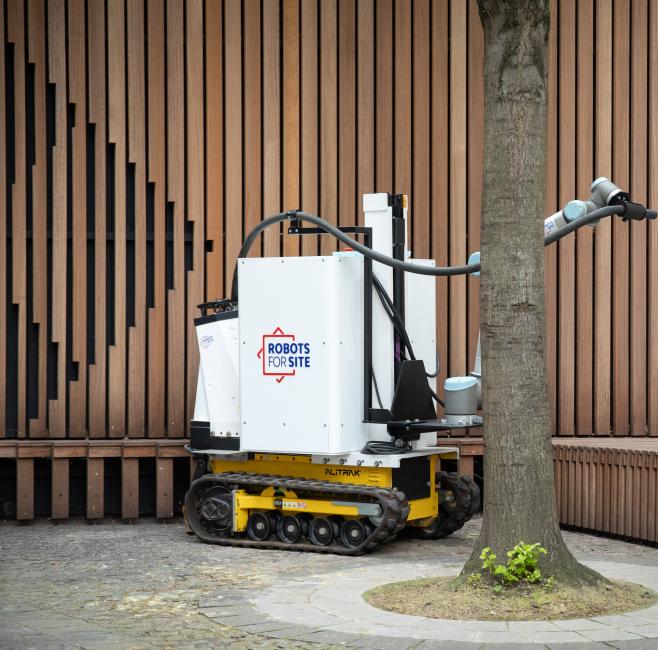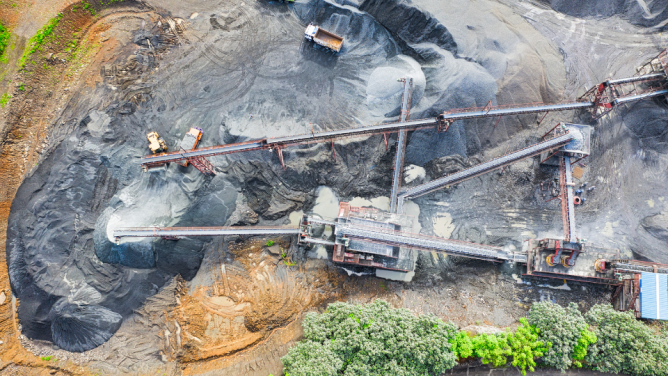Robots are an attractive solution for assisting workers, especially for carrying out repetitive tasks on large-scale construction projects. Several companies have already positioned themselves in this niche market. These include Paco, a collaborative painting robot designed by the French company Les Companions, designed to carry out interior painting work in new builds or refurbishment projects. Or Tomorobo, an autonomous robot designed by Japanese company Ken Robotech and brought to Europe by the German company Baumotor to carry out steel reinforcement fixing work. The solution promises to make 11,000 ties per day instead of 6,500, the number a human worker makes on average, and reduce the risk of injury.
It’s no wonder then that one of the main applications of collaborative robots in the construction industry is to take over dangerous tasks to better guarantee the safety of workers. American company Raise Robotics designed already a few years ago a robot that can carry out high-precision operations on facades, which effectively limits the risk of falls for human workers. Safety is also one of the aims behind Robots for Site, a VINCI Energies’, whose machines, which include a sanding robot, a drilling robot and a robot specialized in material handling, aim to reduce accidents, but also reduce worker’s participation in repetitive, demanding tasks and reduce the risk of illnesses and injuries on dangerous sites.
“The high concentration of crystalline silica dust poses health risks, particularly when drilling or sanding concrete intensively. We are approaching, albeit to a lesser extent, the asbestos or nuclear context, and levels of protection, resources and protocols are required and effective working times reduced”, explains Frédéric Le Hent, Business Manager at Robots for Site.
Deployment hampered by one-off projects
Unlike other industries, such as the automotive sector, the construction industry is made up of unique worksites, which often means that the robots used have to be adapted, thereby limiting the use of a completely standardised solution.
However, the use of parametric AI could open up new prospects for enhancing the learning capabilities of robots. The gradual miniaturisation of robots could also facilitate their use in less standardised environments than new buildings.
A still fragile business model
The second obstacle is cost and the business model: robotic technologies are still expensive to purchase, implement and maintain, limiting access to them to the big players in the market. For this reason, many companies are increasingly marketing their solution as a service platform, with a package that includes deployment of the robot on the worksite and training of personnel in its use.
‘As a robot represents a significant cost, a company’s acquisition is not always profitable, because the performance of this type of equipment depends on its utilisation rate. The rental model, by contrast, allows a machine to be hired only for a given mission. What’s more, a robot represents a wealth of technology, requiring experts capable of maintaining, repairing and troubleshooting it. By renting a robot, you are also renting this expertise, without having to hire programming and industrial robotics skills for the user company,’ explains Frédéric Le Hent.
Growth in the sector driven by demographics
While the market is currently rather modest, it could grow rapidly in the years to come. The global market is expected to experience average growth of 15.5% per year between now and 2029, going from $383.11 million today to $787.48 million. This figure certainly remains modest compared to the construction market as a whole, which is expected to be worth more than €17,000 billion at that point. In the longer term, the sector could benefit from a fundamental trend: demographics. In areas where the population is ageing rapidly, robots could provide a solution to the labour shortage. And in areas of strong demographic growth, robots could help to build new infrastructure more quickly to accommodate the growing population. According to Redshift, the industry must construct 13,000 buildings per day worldwide from now until 2050 to support the expected population of seven billion people living in urban areas.
The benefits of 5G deployment
If robotics are to be used on a construction site, the right communication infrastructure must already be up and running. The 5G rollout is certainly a significant plus: unlike previous generations, it operates on three frequency spectrums, each of them being designed for a different type of connected object. The network is capable of automatically juggling between these three frequencies, which makes it easier to use different robots on the same network, thus considerably increasing productivity and reducing energy losses in factories.
With 5G, data can be processed closer to the source with edge computing, with response times reduced to a few milliseconds for robots, making them safer and more efficient. Increasing 5G coverage is therefore essential to making the uptake of construction robots more widespread.
Although the Robots for Site machines are not connected for the moment and operate autonomously or remotely, depending on the context, ‘5G will enable us to monitor the existing fleet, usage rates and events, measure performance and ensure that we can control the entire fleet of machines remotely’, explains Frédéric Le Hent.
Robots helping lower the industry’s impact
Robotics inevitably consumes energy. However, this energy must come from renewable sources to avoid the use of robots leading to an increase in fossil fuel use. Yet, robots produce productivity gains and therefore energy savings, thus making them compatible with reducing greenhouse gas emissions.
Furthermore, robots can be used to help recycle and reuse materials, two major challenges for implementing less carbon-intensive construction, as Lehent explains. “We are also looking to develop robots that can help recycling directly on site. For example, robots that are capable of reusing glass from a facade and integrating it into silica or concrete. Imagine giving the glass to a small robot integrated on site, which will be responsible for analysing, disassembling, sorting and recovering the material to be able to reuse and encorporate it elsewhere.”
Among the prospects for the development of robots in the construction industry, Frédéric Le Hent envisages their use in the recycling and reuse of materials, particularly in the rehabilitation sector. “We’re looking to develop robots that facilitate in situ processing. We’re talking about reusing glass from facades, for example, to reintegrate it into concrete. We could imagine robots capable of deconstructing, disassembling, sorting and recovering the material so that it can be reintegrated into the construction materials.
We could also develop robotic islands to prepare kitting for construction sites, or to make prefabrications in situ and deliver them to the right place. This would make it possible to manage supplies, thereby reducing the amount of transport needed to the construction site.”
Although robotics is not designed to solve all problems, robotics does however provide a real opportunity to create a construction industry that’s more efficient on so many levels. Industry stakeholders have are not wrong and are investing in this technology, right and left.



